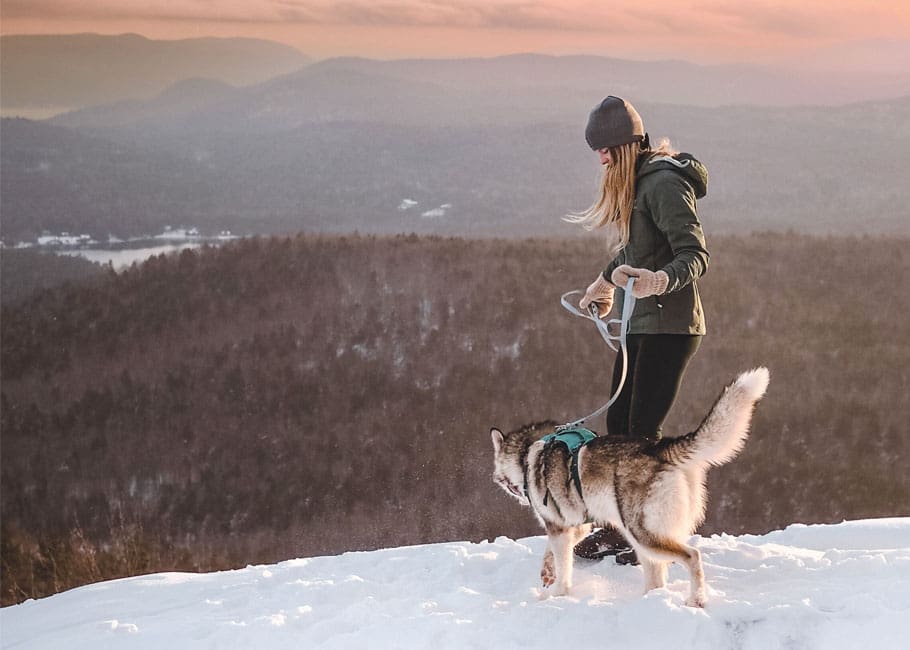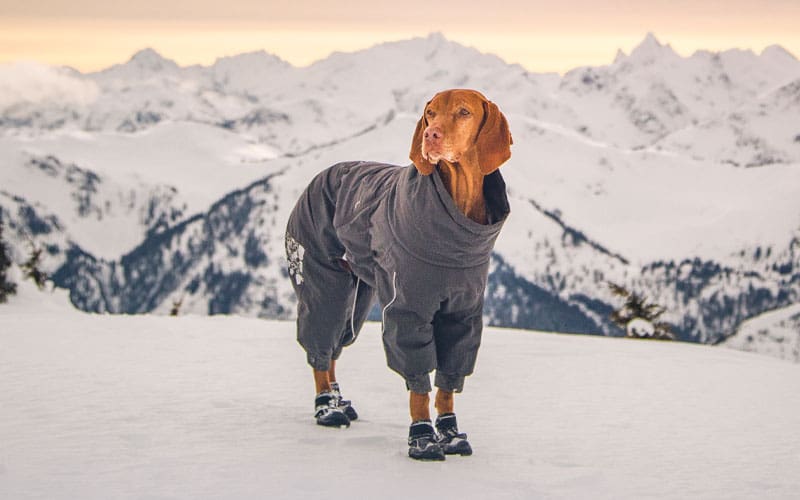
Adjust the length of your hike to your dog’s fitness level
BRITTANY ALLEN
Fun with your Fido
Tips for enjoying outdoor winter adventures with dogs
by Jennifer Mellace
Are you looking to take your pup on some fun explorations this winter? Maybe a hike in the mountains, cross-country skiing on your favourite trails or even a snowshoe trek in your own backyard? Here are a few things you need to know before you go.
Know your dog’s breed
Not all dogs are created equal. Before heading out, consider your dog’s breed and whether or not they can adapt to the colder temperatures.
Costco member Adele Ng from Squamish, British Columbia, adventures with her two short-haired vizslas. They can often be found hiking in the mountains and cross-country skiing. Part of her routine requires a dog wardrobe that varies with the temperatures and precipitation. “I pay attention and know that if they’re slowing down, they’re probably getting cold and I need to add a layer,” she says.
Smaller dogs can enjoy the winter action, too. Ngaio Hotte, also from British Columbia, enjoys winter hikes, snowshoeing and cross-country skiing with her pug and older Labrador-mix rescue. “I have to be sure [the pug] is well-dressed because his tolerance of the cold is much less,” Hotte says. “Usually, the hike up keeps him warm, but if we stop for a while, he gets cold. So, I bring a doggie sleeping bag and a backpack so I can carry him down.”
Brittany Cummings lives in upstate New York with her six pups, four of which are Northern breeds that can withstand colder temperatures. “They were built to endure long days and extreme temps, and some days they are the ones motivating us to get out there,” she says.

Being prepared ensures a fun time for everyone
ADELE NG
Train a solid recall
A reliable recall is important for safety purposes.
“Obedience training is a big part of what we do so we can go out safely,” Ng says. “We have bears, cougars and wolves where we hike. If I want to go out, I still take my dogs and I expect them to listen.”
“One of our biggest fears is ice—the dogs falling through on lakes or slipping on scrambles during hikes,” Cummings adds. “For this we make sure we have solidly trained commands for recall and wait, and we leash the dogs in areas of concern.”
Know your dog’s limits
“When temperatures fall below -6.7 C (20 F) it’s best to limit exposure to the elements for extended periods,” says Dr. Liam Bisson of the Shelburne Veterinary Hospital in Shelburne, Vermont. It’s also important to protect sensitive paws with dog boots or a layer of petroleum jelly or wax made specifically for dog paws. “Also be sure to inspect your dog’s feet after time spent outside and wash off any salt or chemicals,” the Costco member says. “Ingesting those chemicals can make your dog ill.”
Knowing your dog’s level of fitness is key. If you’ve ever hiked through the snow, you know the extra energy it takes, and it’s no different for your dog. It’s also a good idea to carry treats and water so that your dog can replenish calories and stay hydrated.
Ng uses canine conditioning exercises to help her dogs stay strong. She also takes preventative measures by feeding them a joint supplement.
“Don’t push a dog [that] is too old or too young,” she adds. “And if you have a puppy, wait until they’re fully grown— at least 1 year old—before you start anything strenuous; especially skiing.”
Ng’s best advice is to listen to your dog. “Try different things and see what they like. If your dog is happy, that’s what matters in the end.”
Caution in the cold
If your dog goes into the water, don’t panic. Many breeds have thick coats, which give them added protection against the elements. However, prolonged exposure for these breeds, or for breeds with short coats, may lead to hypothermia. It’s important to get them inside and dried off. Making sure your dog is well-hydrated before an outing can also help head off hypothermia. Things to watch out for include shivering and lethargy, says veterinarian Dr. Liam Bisson.—JM
Adventuring with a reactive dog
Ngaio Hotte of British Columbia adopted her Labrador retriever mix and quickly learned that he was reactive to other dogs. Instead of forcing him into situations, here are a few strategies she uses to get him on the trails safely:
- Choose trails with good visibility and no surprises.
- Bring a friend and their dog to intercept and distract off-leash dogs.
- Consider popular on-leash trails.
- Embrace the muzzle—a signal to other people that your dog wants space.
- Know your dog’s limits and choose trails accordingly.—JM
Jennifer Mellace is a freelance writer in Frederick, Maryland.
Costco Connection: The Kirkland Signature™ Pet Logo Hoodie (Item 1731628) can be found in Costco warehouses. Costco offers a variety of gear and other products for outdoor enthusiasts and their pets in Costco warehouses and at Costco.ca.

